
September 14 - December 13 2009
Curated by Christof Migone
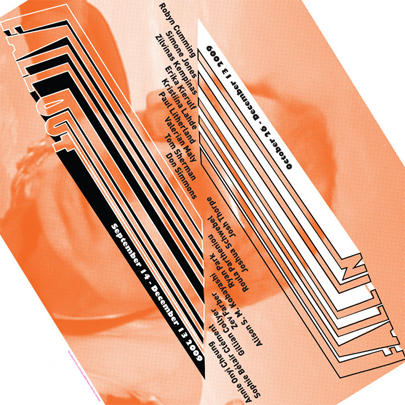

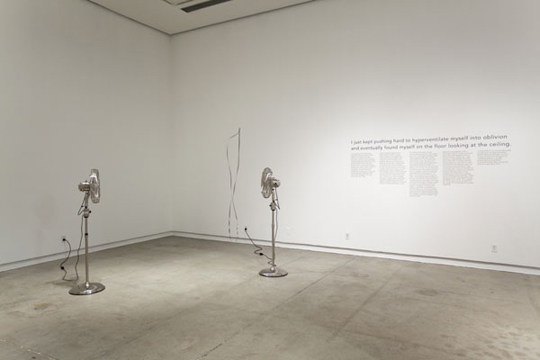

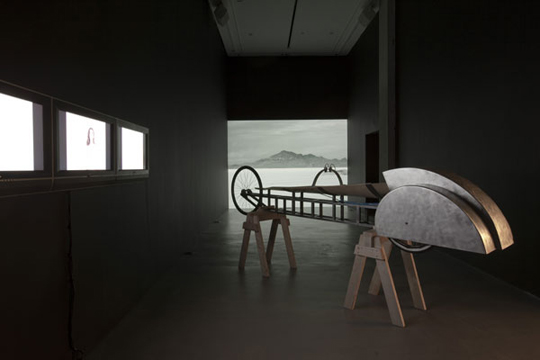
Sunday Sept. 20, 11:30-5:30pm. ARTBus Tour. Bus departs at 11:30am from OCAD (100 McCaul St) for Oakville Galleries, Blackwood Gallery and Art Gallery of Mississauga. Snacks and refreshments will be provided. Cost: $10. To register, please call Oakville Galleries at 905-844-4402 by Friday Sept 18.
Sunday Sept. 27, 12-5pm. FREE Contemporary Art Bus Tour. Starting at noon at the ROM (100 Queen's Park) with exhibition tours organized by the Institute for Contemporary Culture and the Koffler Gallery, bus departs for Doris McCarthy Gallery, Art Gallery of York University and Blackwood Gallery. To reserve a seat, please call 416-638-1881 ext.4270 by Friday Sept. 25.
Sunday Oct. 18, 10–4pm. Regional Art Bus Tour. Tour starts at 10am of the Art Gallery of Mississauga (AGM), then departs for the Art Gallery of Peel, Gallery Streetsville and the Blackwood Gallery and returns to theMississauga Civic Centre at 4pm. Coffee and refreshments will be provided and there will be free time for lunch in Streetsville (lunch is not provided). Free underground parking available at the Mississauga Civic Centre. Cost: $15. To register, please call the Art Gallery of Mississauga at 905-896-5088 by Friday Oct. 16.
Sunday Nov. 8, 12-5pm. FREE Contemporary Art Bus Tour. Starting at noon at the ROM (100 Queen's Park) with exhibition tours organized by the Institute for Contemporary Culture and the Koffler Gallery, bus departs for Doris McCarthy Gallery, Art Gallery of York University and Blackwood Gallery. To reserve a seat, please call the Doris McCarthy Gallery at 416-287-7007 by Friday Nov. 6.
Live the lives, live them all,
Keep the dreams separate,
See: I rise, See: I fall
Am an other, am no other.
Paul Celan (1)
An exhibition bound by gravity. An exhibition where to be bound by gravity will be considered, diverted, inverted. Some work will defy gravity (Kempinas), others will simultaneously defy and confirm its inevitable pull (Litherland and his skydiving projects). Yet others will allude to the rise and fall in Celan’s epigraph and feature the ebb and flow of breathing (Keirulf) as well as his notion of the self as ‘other’ (Jones with her implicit reference to The Man Who Fell To Earth). Tactics involving wind and magnetism, amongst others, are recruited to counter the fated force of attraction which ties our feet to the ground and keeps the Earth spinning around the Sun. Orbits are relationships defined by thwarted falls, they dance the push and pull pairing of two bodies. The physiological and psychological impact of gravity will warrant particular attention in this exhibition (with a special nod to Philippe Halsman's Jumpology project). Fall Out will also be a study of outcomes, epiphanies and consequences (Maly).
It will be an examination of remnants and how they act as triggers in perennial permutation—in other words, Fall Out will dwell on a fall out that never settles.
Fall Out will be followed by Fall In. Artists in the second exhibition will respond to the works in the first exhibition. During Fall In both will coexist in the gallery.
The pairings:
Annie Onyi Cheung will respond to the work of Simone Jones
Sophie Bélair Clément will respond to the work of Tom Sherman
Gillian Collyer will respond to the work of Kristiina Lahde
Zev Farber will respond to the work of Valerian Maly
Alison S.M. Kobayashi will respond to the work of Paul Litherland
Ryan Park will respond to the work of Erika Keirulf
Roula Partheniou will respond to the work of Zilvinas Kempinas
Josh Schwebel will respond to the work of Robyn Cumming
Josh Thorpe will respond to the work of Don Simmons
Fall Out
Fall Out Fall In
Fall Out Fall In Fall Through
Fall Out Fall In Fall Through Fall From
Fall Out Fall In Fall Through Fall From Fall To
Fall Out Fall In Fall Through Fall From Fall To Fall With
Fall Out Fall In Fall Through Fall From Fall To Fall With Fall Under
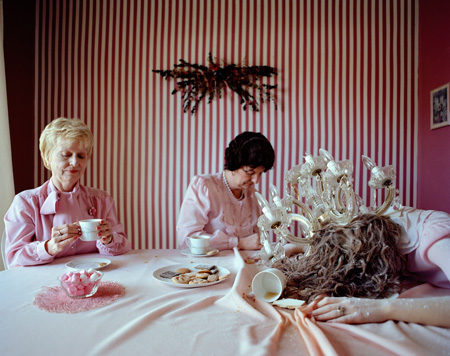
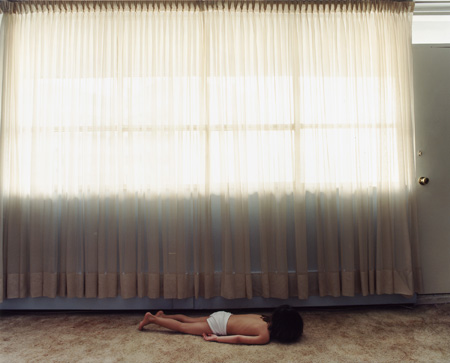
The photographic series Little Legs explores my fascination with human beings and our relationship to objects and environments. It explores the strangeness and absurdity one experiences in being human and embraces the performative nature of our everyday existence. The images present certain truths that can only be unearthed by photography’s capabilities to explore the virtual, to explore those things that often remain hidden. It is in these small ruptures; a gesture, an absurd moment, the texture of a certain fabric or a mesmerizing pattern, that one can connect to something very real and yet often manifest only in these fictions. The constructed image can act as a story that, though utterly fictitious in all respects, lends more insight than reality ever can. The images ultimately mine the allusive and intriguing nature of memory and trauma. In attempting to manifest something that one finds incredibly hard to articulate, I have found traces of these experiences in the simplest of places. In a thrift store drapery, the gesture of ones finger, the quality of light falling on a papered wall; it is in these places that affective experiences unearth themselves. Similar to the way your neck hair raises when you’re walking about and catch the dull scent of you grandmother’s face cream. I have found that it is in affective experience where the everyday can become extraordinary, where the most mundane of things can become infused with intense and moving significance. For us to come across them is just a matter of luck.
In Oh, Mother, my interest is the strange space in which the entity of the mother exists. There is this tension that surrounds the mother—all at once sacred and exalted yet simultaneously hysteric. The mother is worshipped as an ideal that is holy, un-tainted and wildly unrealistic, therefore, her mistakes, her simple flaws, make her fall from grace all the more tragic. The mother becomes this myth, a sort of exaggerated image of herself and of all the contradictory qualities that have come to define her. In essence the mother is beautifully flawed because she is irrevocably human. In the creation of the work I’m attempting to mine these qualities from all the stuff that has become ingrained in our cultural psyche and then build my subject up into something momentous and iconic that oscillates from beauty to the grotesque and horror to fantasy. The work consists of a series of large scale photographic portraits of mothers performing as mothers. So you have the idea of the mother and then the acknowledgment, confrontation, dramatization and undermining of that idea. In a sense the work becomes a sort of collaboration between me, a daughter, and the mothers who have agreed to pose for me.
Robyn Cumming makes things and then takes photos of them. She enjoys forcing her friends and
family to pose for her in intriguing but awkward and unattractive positions. Her work has been exhibited throughout Canada and in New York and Asia, and can be found in private and public collections worldwide. She was recently featured in a new series about Canadian photographers titled Snapshot on BRAVO but she’s really self-aware and finds the whole thing pretty embarrassing.
http://robyncumming.com/
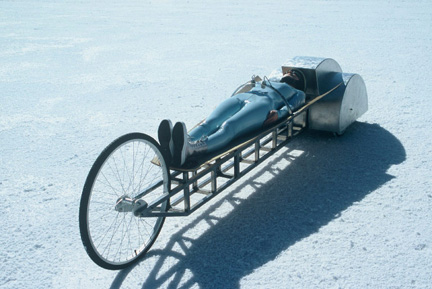
Simone Jones, Perfect Vehicle, 2003 - 2006, photo: Hope Thompson
The premiere presentation of this installation which includes video projection and vehicle. The video documents the
workings of an 11 foot-long, three wheeled machine that is propelled
by breathing. In order to move, the vehicle harnesses the up and down
motion of the rib cage as the "driver" breathes. Shot on the
Bonneville Salt Flats, Salt Lake City, Utah, in 2006.
Simone Jones has been making kinetic sculpture since 1989. Most
recently, her work has expanded to include film, video and
performance. Recent exhibitions include two international tours:
Resonance: The Electromagnetic Bodies Project and Points of Entry as
well as two shows in Pittsburgh: Displacement, at the Regina Gouger
Miller Gallery; and Sculpture Now, at the Pittsburgh Center for the
Arts. Jones has received numerous grants for her work including a 2003
Media Arts Grant from the Canada Council and a 1999 Arts Toronto
Protégé Award. Jones has served on the Board of Directors of the
Liaison of Independent Filmmakers of Toronto (LIFT) and InterAccess
Electronic Media Arts Centre. Jones graduated from the Ontario College
of Art with a concentration in Experimental Art and received her MFA
in Sculpture Installation from York University. Jones is currently an
Associate Professor in the Faculty of Art at the Ontario College of
Art & Design.
Director: Simone Jones and Wrik Mead
Director of Photography: Ryan Randall
Swing: Cliff Caines
Production Manager: Hope Thompson
Editor: Martin Iskander
Sound Design: Tom Third
Vehicle Construction: Maxwell Design
This project was made possible with the generous support of the Canada Council.
Special thanks to: Hope Thompson, Liaison of Independent Filmmakers of Toronto (L.I.F.T.), Roberto Ariganello, Don Pyle, Kim Derko, James Maxwell, Bureau of Land Management (Salt Lake City, Utah), Technicolour Creative Services – Toronto, the Integrated Media Program at the Ontario College of Art & Design (OCAD).
http://simonejones.com/

Zilvinas Kempinas, O (Between Fans), 2006, magnetic tape, fan, dimensions variable,
edition of 6, photo courtesy of the artist and Spencer Brownstone Gallery
Two fans face each other and generate an air pocket which enables a loop of video tape to float and fly, dance and twirl. The fact that it stays up is magical, however there is no magic, all is apparent and undeceptively simple. The standard playback machine for videotape decodes images and sounds from within it, hidden inside a casing; now the machine is in the open, all too visible, and the content encoded on the tape remains dark and mute. This air machine activates the tape itself not along a particular path but in an aleatory mode within an invisible area of containment. The activated tape activates the space and moves the movie.
Zilvinas Kempinas was born in Lithuania in 1969 and has been living and working in New York since completing his MFA in 2002. The artist’s unique installations often use unspooled videotape and electric fans to conjure transfixing visual conundrums. He is represented by the Spencer Brownstone Gallery. He has had recent solo museum exhibitions at Palais de Tokyo, Paris and the Contemporary Art Center, Vilnius. In 2007, the artist was highlighted by Art Review Magazine as one of its 'Future Greats: 25 Artists You Need to Know', and received the Calder Prize and Atelier Calder Residency Award. At the 2009 Venice Biennale, he represented Lithuania with his installation "Tube" (tubeinvenice.com).
http://www.spencerbrownstonegallery.com/Artists/Zilvinas_Kempinas/
http://www.initiartmagazine.com/issue01_SRzp.html

Erika Kierulf, Jonathan, still from Untitled (Studies for Breathe), 2006
In the silent installation Breathe, individuals walk from one frame into another, stop, face the camera, and after several intimate moments, lean backwards and slowly fall out of the margins of the space. The wait before the fall is a crucial moment, as viewers are witness to each subject’s moment of hesitation or doubt: eyes that flicker or sometimes close, muscles that contract, empty gazes. Because of the repetition of the fall, the viewer can expect to witness the same gesture; but what remains unique in each portrait is the expression of the subject and their self-awareness as they gradually let go.
Erika Kierulf is a Montreal-born visual artist who completed an MFA at Concordia University in 2007. Her photographic and installation work has been shown in Canada, Sweden, and Mexico. Concerned with issues of intimacy and the banal, she explores emotional and bodily states of in-betweenness.
http://erikakierulf.com/
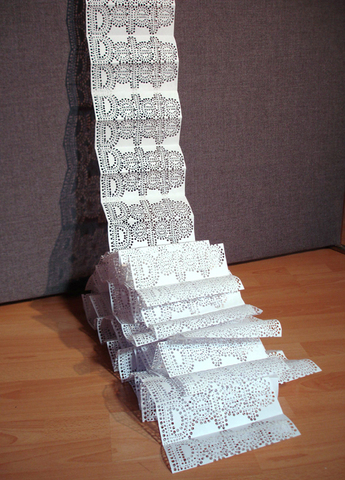
Delete equates the experience of data processing with that of hand crafting lace. The word 'delete' has been repeatedly punched into a continuous length of computer paper. This handmade process is precise and labour intensive. The result of this subtractive mark making process resembles a bolt of lace or data spewing from a computer.
Kristiina Lahde is an artist based in Toronto, Canada. She received her BFA from the Nova Scotia College of Art and Design in Halifax N.S. in 1999. Kristiina works in collage, sculpture and installation. Her work has recently been exhibited in Toronto at Convenience Gallery in April 2009. This Fall Kristiina’s work will be in an exhibition at the Texas State University Gallery titled Of, On or About: 50 Paper Works. Kristiina is working towards an exhibition at MKG 127 opening January 2009.
http://www.kristiinalahde.com/

This is my 30th year of skydiving, the anniversary of my first jump is September 29th. I made my first jump in Gananoque in 1979 while studying sciences at Queen's University. I was only 17 and lied about my age to sign the waiver so I could take my first jump course. As of July 21, 2009, I had 1688 jumps.
Credits for Freefall Fighters: Performers: Bertrand Cloutier and Paul Litherland; Video: Yannick Langevin and Bertrand Cloutier; Video Editing: Monique Moumblow.
Photographer and multimedia performance artist Paul Litherland lives in Montreal and performs at Multimedia Art festivals and events. His work incorporates ideas of risk taking, finding strengths in unexpected places and creating artworks with a sense of humour. Media and ideas he works with include digital photography, digital video, performance art, base jumping, skydiving, boxing, street interventions, vulnerability as strength, exposure to risk, and poetic combinations of materials and histories.
http://paullitherland.com/
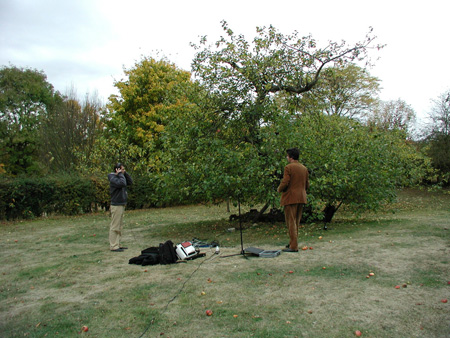
Recordings from Sir Issac Newton's Apple Tree, Woolsthorpe Manor, Lincolnshire, England, October 18, 2003.
If one opens a German-English dictionary to the term ‘Fallobst’, one finds a word that encompasses everything contained in this recording: ‘windfall’. This word, in English, is not only used to denote ripe fruit that has fallen to the ground, it also describes ‘an unexpected stroke of luck’.
It must be several years ago now that my wife and I found ourselves wandering through a pear orchard in the village of Kehrsiten on the Vierwaldstatter Lake near Lucerne, Switzerland. Enveloped by the darkness of night and undisturbed by surrounding noises, we listened to the sound of ripe pears as they fell to the ground—a sequence of events of surprisingly remarkable sounds and structures. It was also an ‘unexpected stroke of luck’, because in these abrupt and unpredictable events of concentrated density, I could recognize everything that engages me as a sound artist and composer: creating an energy of attentiveness that is indeterminate and unpredictable in the Cagean sense, yet which retains a narrative, metaphorical overtone. It would be exaggerated to identify a matrix of my sound art in the pear orchard and its aural outcome, but in any event, it is an ‘unexpected stroke of luck’ to listen to the noise of the falling fruit and to find pleasure in it: the sudden rustling of branches as the fruit falls through them, followed by the sound of its impact, a dull thud in the damp grass of the night. Here, the static (the motionless tree) meets the dynamic (the falling fruit). The process ripening of the fruit also fascinates me: this ‘little bit too much’, the extra few cells which have been enriched with water, making the fruit too heavy to be held by the branch, the maturation, reached at some point in time, which lets the pear or apple fall.
In 1998, I read what for me appeared to be a sensational news item: an apple tree under which, according to legend, Sir Isaac Newton made his observation of the famous falling apple, has been scientifically demonstrated to still exist.
In Contemporary Physics, R.G. Keesing published the article The History of Newton’s Apple Tree (An investigation of the story of Newton and the apple, the history of Newton’s apple tree and its propagation from the time of Newton to the present days). Ever since reading this article, I planned a sound installation using recordings of apples falling from Sir Isaac Newton’s famous apple tree.
It was ‘an unexpected stroke of luck’ that Nicolas Collins sent me the Call for Silence, and so, from October 17 to 19, 2003, I traveled with my colleague and former student Oliver Friedli to the Woolsthorpe Manor in Lincolnshire, Newton’s place of birth, to record apples falling from the original tree in surround-sound. The birth house lies nestled in an almost forgotten, picturesque landscape, with its fruit orchard, free-range chickens (all descended from Newton’s time) and bleating sheep of a rare species. The atmospheric impression is however dreadfully clouded by an incessant, ubiquitous noise; if only Highway A1 were not in the vicinity! Hardly more imaginable is what William Stukley noted in his diary on the occasion of a visit to Newton in 1725/6: After dinner, the weather being warm we went into the garden and drank thea, under the shade of some apple branches, only he and myself. Amidst other discourses, he told me that just in the same situation, as when formally the notion of gravity came into his mind. It was occasioned by the fall of an apple, as he sat in a contemplative mood.”
Despite the omnipresent noise, I decided to use only original recordings from these environs for this production. Noise is a daily reality and if one listens into its internal structures, one might also discover some fascinating sound processes.
I am especially grateful to Susan Haimes, Property Manager of Woolsthorpe Manor, and her colleagues who made the recordings at this historic monument possible in an unconventional and uncomplicated way. Also unforgettable is the English tea that was served to us beneath Newton’s apple tree.
With support from the Hochschule der Kunste Bern, Department of Music and Media Arts. English translation: Laurie Schwartz. Sound design: Oliver Friedli.
Valerian Maly, born in 1959, lives in Bern (Switzerland) and works in the fields of inter-media, performance, installations. He studied Music at the Music Conservatory in Luzern. He is professor at the Hochschule der Künste Bern (HKB), teaches History of Media Arts, Performance Arts & Performing Arts.
http://www.medien-kunst.ch
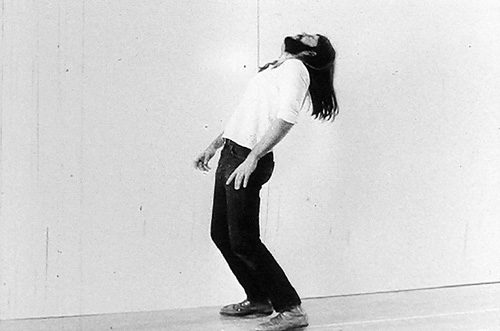
Tom Sherman, Hyperventilation piece (1970). Photo credit: Andrew Lugg.
For Fall Out, Sherman will present a text version (included below) of the first performance for video of Hyperventilation piece (1970). A video of Sherman reperforming Hyperventilation piece for Andrew Lugg's 1972 film "Trace" will be featured in Drop Out, the Blackwood Gallery’s event for the 2009 edition of Nuit Blanche at Hart House, U of T.
I was hanging around Ypsilanti, Michigan, having finished my BFA degree in sculpture at Eastern Michigan University. I was 23 years old, bean-pole thin and had shoulder-length straight dark brown hair and a full black beard. I had met John Orentlicher who had just joined the faculty. John said he heard I might be interested in working with video equipment. He told me he had booked some video gear for over the Christmas break, December 1970, and if I was interested, we could experiment with video.
I said I wanted to document a performance in which would hyperventilate until I passed out. I had never hyperventilated until I blacked out but thought it was possible. We set up a camera on a tripod at chest height. I taped a line on the floor with its far end about ten feet from the camera. It formed a 'runway' toward the camera and had perpendicular strips of tape at one foot intervals. I stood at the far end of the line, facing the camera, and had John frame me so I was in the shot from the waist up. Then he started recording, I became still, concentrating while I looked directly into the camera, and then began to inhale and exhale the deepest breaths I could.
According to the plan, at one minute into the exercise John called out “one” and I took one step closer to the camera. After two minutes John called “two” and I advanced another foot closer. By about the four minute mark I was beginning to feel spasms rippling through my abdominal muscles and my arms and hands were curling in at my sides. By the fifth minute I was labouring hard and my breathing was a hoarse roar, and beside the contractions in my torso I was drooling thick strings of saliva. I was getting light headed but the burning intensity of the exertion was keeping me grounded. I just kept pushing hard to hyperventilate myself into oblivion and eventually found myself on the floor looking at the ceiling. I had fallen completely out of the frame at six minutes and forty seven seconds. My legs had buckled and I had hit my left hip and the back of my head on the floor before I had come to a rest.
Watching the playback of the recording, I was in a close-up by the time John had stopped counting at five minutes, as planned. I was heaving in and partially out of the frame with each convulsing breath. On the tape you could see my eyes roll back into my head as I spun out of the frame and went down. The camera showed only the wall behind me as the video camera’s microphone recorded the percussion of my collapse and continued to capture heavy breathing from the floor. There was some relief in the respiration as I was gasping for breath from outside the frame. John let me lie there for the couple of minutes before I pulled myself up.
I carried the ½ inch reel-to-reel video recording of my hyperventilation performance around with me for a couple of years and showed it to interested parties in private screenings here and there. It was lost shortly after I moved to Toronto in the fall of 1971.
Founding co-editor of Fuse magazine, Toronto, 1980; represented Canada at the Venice Biennale 1980; founding Head of Media Arts section of the Canada Council for the Arts, Ottawa 1983-87; international commissioner for Venice Biennale 1986; appointed director of the School of Art and Design, Syracuse University 1991; co-founded Nerve Theory, an international performance art/recording collaborative 1997; awarded the Bell Canada prize for excellence in video art 2003.
http://transmedia.syr.edu/sherman
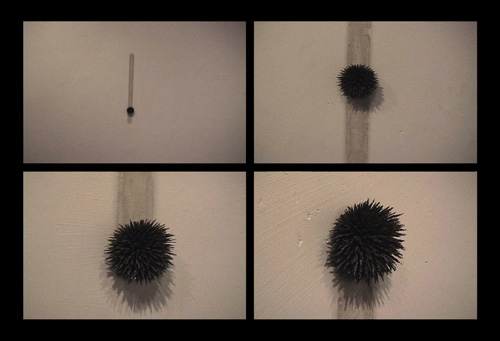
Materials include a magnet, iron filings, custom designed machine. Based on Marcel Duchamp's The Bride Stripped Bare of her Bachelors, Even, this revisiting is another mystery machine that follows no logic. The viewer sees the iron filings moving up and down a wall, and can peak behind the wall to view the technological device that lies behind the surface. This artwork, like Duchamp's work, is a masturbating machine.
Originally from St. John's, Newfoundland, Don Simmons is a conceptual artist/writer based in Toronto, Canada. Simmons completed his MFA degree at NSCAD in 2002. Previously, he had studied art history in Italy while completing his diploma at OCAD. His writing has appeared in Parachute (Montreal), Image and Text (New Zealand), and Handheld Media (Calgary). Simmons has held teaching positions at the Alberta College of Art & Design, NSCAD University and the Art Gallery of Ontario.
http://www.donsimmons.net/